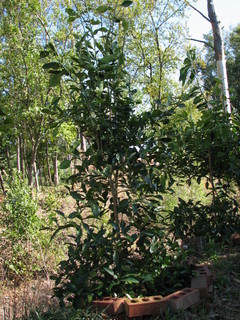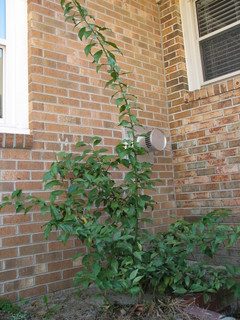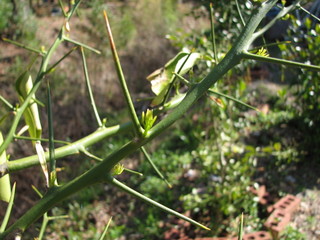It was officially the coldest winter in the 136 year history of Wilmington NC's climate record -- yet somehow I've still got 16 citrus trees alive in the yard! The official December through February average temperature at the Wilmington airport was 42.4 degrees Fahrenheit which beat out the winters of 1976-1977 (42.5 degrees) and 1903-1904 (42.6 degrees). Much like last winter we never had really extreme cold on any one night, just consistently below-normal temperatures through the entire winter season. The top inch or two of the soil actually froze for a few days during the coldest weather; that's two years in a row that's happened now.
The coldest temperature observed this winter was 17 degrees on the morning of January 23st, still technically in USDA zone 8b.
Most of my trees were covered with high-density frost cloth (Atmore GG-60) on nights when temperatures were forecast to fall well below freezing. At the base of each tree was a 60 to 100 watt incandescent light bulb to provide supplemental heat. The 100-watt bulbs were used on the larger trees; the 60-watt bulbs were for the small trees. The covers and lights were used for about 25 nights this winter. None of my trees have been in the ground for more than three years, most for only two years.
Here's a rundown of how the various varieties held up:
Ambersweet Orange - Two trees both experienced 60 percent defoliation and about 10 percent stem die-back. They started sprouting new leaves about March 7th and are looking very nice now on March 14th. Both are on their own roots (ungrafted).
Bloomsweet Grapefruit - Two trees experienced about 10 percent defoliation and no stem die-back. Today on March 14th I'm seeing new leaves starting to spout on both trees. Both are grafted to poncirus rootstocks.
Changsha Mandarin - Three trees experienced about 10 percent defoliation and no stem-die back. They're all on their own roots. As of March 14th I'm seeing tiny new leaves just about to pop open along the stems.
Ichang Lemon - Two trees, one is grafted to poncirus rootstock and one is on its own roots. Both had less than 5 percent defolation and no stem die-back. No new leaves noted as of March 14th.
Brown Select Satsuma - One tree, grafted to a poncirus rootstock. Experienced 10 percent defoliation and no stem-die back. New leaves started growing about March 10th.
Owari Satsuma - Two trees, both grafted to poncirus rootstocks. Defoliation ranged from 5 to 10 percent with no stem die-back. New leaves began growing around March 10th.
Sanbokan Grapefruit (Citrus sulcata) - One tree, experienced 90 percent defoliation and about 20-30 percent stem die-back. This cultivar might be hardier than my experience indicates because the light bulb used for heating burned out for at least one or two nights before I noticed and replaced it. The Sanbokan is on its own roots. As of March 14th I'm seeing new leaves sprouting out.
Ten Degree Tangerine - Two trees, both are grafted to poncirus rootstocks. The importance of microclimates really became apparent with these trees: one planted out in the middle of the yard experienced 80 percent defoliation and 10 percent stem die-back. The second tree, planted up against a brick wall next to a gas fireplace vent, experienced no defoliation or die-back and started growing new leaves on March 4th. Unlike all the other citrus trees I made no attempt to cover or heat either Ten Degree Tangerine this year.
Yuzu - One tree, grafted to a poncirus rootstock. It experienced about 10 percent defoliation and no stem die-back. No new leaves noted as of March 14th.
A few pictures...

Looking north along the 'grove.' Ichang Lemons to the right, Changsha Mandarins to the left.

Ichang Lemons, only lightly damaged by this winter's cold.

A Ten-Degree Tangerine tucked back in a warm corner

Some new leaves popping out on an Ambersweet Orange

Brown Select Satsuma









